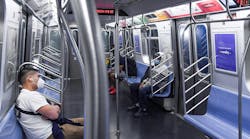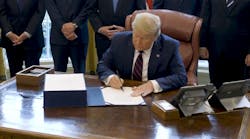New York’s Metropolitan Transportation Authority (MTA) is facing challenges Chairman and CEO Patrick Foye calls existential in scope. The fallout of the COVID-19 pandemic, which has seen MTA’s costs increase due to intensive disinfecting and cleaning efforts while revenues have fallen due to ridership drops and anticipated lost tax revenues, has resulted in an expected $16.2 billion deficit by 2024.
MTA’s four-year financial plan projects deficits of $3.2 billion for 2020 and $5.8 billion for 2021 before easing to $3.5 billion in 2022 as riders return. The agency pegs the deficit for 2023 and 2024 to be between $1.8 billion and $2 billion.
“To say that these challenges are existential in scope isn’t an exaggeration,” said MTA Chairman and CEO Patrick J. Foye. “Without further substantial assistance from the federal government, anything and everything must be on the table with respect to responding to financial damage from the pandemic. We are the lifeblood of the region’s economy and the fallout from Washington’s failure to act would have national consequences.”
The MTA has identified $5.13 billion in-house savings through 2024 – the largest cost cutting program in its history – to help stem the deficit. The MTA initially identified $1 billion in savings in 2021 with a focus on dramatically reducing overtime, consultant contracts and non-labor expenses, but explains the efforts to cut costs will be ongoing.
The MTA is currently losing $200 million a week in revenue from fares, tolls, subsidies and COVID-related expenses. By the end of 2020, the agency projects the following losses:
- $4.2 billion in fare losses,
- $2.1 billion in reduced subsidies,
- $880 million in toll losses and
- $500 million in increased expenses.
Through 2024, the MTA projects fare revenue losses of $8.5 billion, tax subsidy losses of $6.9 billion, COVID-related expenses of $2.5 billion and toll losses of $1.8 billion through 2024.
The MTA is one of several agencies to urge Congress to include between $32 billion and $36 billion for transit in a coronavirus relief package. The agency is requesting $3.9 billion for itself to get through the end of 2021 and a total of $10.3 billion through 2021.
The authority was awarded $4 billion through the Coronavirus Aid, Relief and Economic Security (CARES) Act, but will exhaust this allocation by July 24.
Foye appeared on CNBC’s “Squawk on the Street” on July 23 and stated the following:
“This is a national crisis, it requires a national solution. For the MTA our revenues have gone down about 40 percent. Good news is we received about $3.9 billion, close to $4 billion, of funding in the CARES Act… We're going to exhaust the last of the CARES dollars tomorrow. We'll get the last installment from FTA in August. To get us through the rest of the year--our revenues are two sources, $17 billion agency. About half our revenues come from our customers fares and tolls, subways, buses, commuter rail and MTA Bridges and Tunnels. The rest come from a dedicated package of taxes and subsidies that the Legislature has put in place over the last period of decades. Both of those revenue sources are down. We need another $3.9 billion from the federal government to close the deficit through the end of 2020.”
Without further financial assistance, MTA will look at further cost savings steps including wage freezes, delaying the start of new capital projects and reducing the scope of the 2020-2024 Capital Program to modernize the transit system, non-personnel expense reductions, reductions in force, scheduled fare and toll increases, service reductions and long-term deficit financing.
“The fiscal reality of what we’re facing is very clear and very dire,” said MTA Chief Financial Officer Bob Foran. “Without an infusion of billions of dollars in desperately needed federal funds, the MTA simply cannot provide customers with existing levels of service at the current fare cost. Not getting Federal support is not an option for the long-term health of the regional and national economy.”
This story was updated July 23, 2:15 pm to include the draw down date of the CARES Act funding.

Mischa Wanek-Libman | Group Editorial Director
Mischa Wanek-Libman is director of communications with Transdev North America. She has more than 20 years of experience working in the transportation industry covering construction projects, engineering challenges, transit and rail operations and best practices.
Wanek-Libman has held top editorial positions at freight rail and public transportation business-to-business publications including as editor-in-chief and editorial director of Mass Transit from 2018-2024. She has been recognized for editorial excellence through her individual work, as well as for collaborative content.
She is an active member of the American Public Transportation Association's Marketing and Communications Committee and served 14 years as a Board Observer on the National Railroad Construction and Maintenance Association (NRC) Board of Directors.
She is a graduate of Drake University in Des Moines, Iowa, where she earned a Bachelor of Arts degree in Journalism and Mass Communication.





